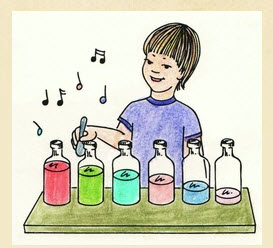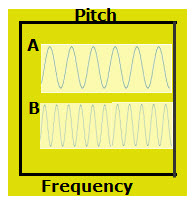Using bottles to make music is fun for kids of all ages. The best presentation I’ve heard were seniors who played “Lean on Me” and along with the music from the various bottles, one student added a drum beat by tapping on the lab table.
It really was awesome–too long ago for me to have captured it on video. OOPS! Guess that makes me older… than dirt.
In the diagram, the bottles are all the same. There is one variable, which is the amount of water. Tapping the bottles with a metal spoon produces a sound.
Sound is a form of wave energy that moves out from the vibrating bottles.
Pitch is how high or low the sound is.
Pitch is determined by the frequency of a sound.
In the diagram below:
The frequency of Sound Wave A is less than the frequency of Sound Wave B. (This is determined by the number of waves in the same time period.)
The pitch of Sound Wave A is less than the pitch of Sound Wave B. (This is determined by the frequency of each sound.)
Question: Which bottle has the highest pitch, the bottle with the least amount of water or the bottle with the greatest amount of water?
Discover for Yourself
How to Make Music with Bottles of Water
Use the same kind of bottles, such as empty glass soda bottles. Fill the bottles with different amounts of water. Using a metal spoon, tap the each bottle and compare the pitch of the sounds produced.
So What’s Happening
Tapping the bottle causes the bottle and its contents to vibrate at a frequency that is audible to the human ear. The pitch of the sound is determined by how fast the bottle and its contents vibrates. As the water inside the bottle decreases the vibrations are faster, which produces a higher pitched sound. You could write the relationship between the volume of water and the pitch of the sound like this: < water volume > pitch . This would be read as: A decrease in the volume of water causes an increase (rising) in the pitch of the sound produced.
Just for Fun!
Try to tune the bottles by adding and subtracting water from the bottles so they can be used to produce notes of a song, such as “Mary Had a Little Lamb.” You can color code the water for specific notes. Since water evaporates, add a drop of cooking oil to each bottle. It will form a thin layer across the water’s surface preventing he water from evaporating. If the drop of oil changes the pitch of the sound, use a long eye dropper (or straw) to remove just enough water to fine tune the bottle.
Challenge
Does blowing across the tops of the bottle instead of tapping them change the sound produced? If so, Why?? For information see, SOUND: BOTTLE ORGAN
Guide to the Best Science Fair Projects
(Paid Link)


